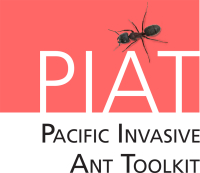Funding sources
First contact your local environment (invasive species) or agriculture department (biosecurity / quarantine) about funding. These organisations may be able to access funding through organisations such as the Global Environment Facility (GEF) and FAO. Implementing agencies such as SPREP and IUCN can assist with accessing funding through the GEF Fund.
If you are looking at starting your own ant management programme, you should know that getting funding for managing invasive ants is difficult. All potential funders require projects to have well-defined goals and be well managed.
You will need to have a good idea of how much the project will cost, and there are resources in the PIAT that can help you with budgeting your project.
Sustainability is a key requirement that funders are looking for. So if you are going to propose management of invasive ants, it is important to also focus on biosecurity.
Most funders have restrictions on the provision of funding for pesticide use, so demonstrating sound Environmental Impact Assessment and prevention of non-target effects will be important. If you are not experienced or confident with the funding process, consider partnering with a regional agency or organisation or a technical expert who understands mitigation of environmental and social risks.
Potential funders
The Critical Ecosystems Partnership Fund (CEPF) is a joint initiative of l'Agence Française de Développement, Conservation International, the European Union, the Global Environment Facility, the Government of Japan, the MacArthur Foundation and the World Bank. CEPF focuses on enabling civil society participation in biodiversity conservation where it matters most. They fund projects that meet certain eligibility criteria and that have appropriate environmental and social safeguards. As at April 2016 CEPF only fund projects with a cost of less than 1 million $US.
SOS (Save Our Species) offers grants targeted at positive conservation outcomes for threatened species. SOS provides two types of grants. Threatened Species Grants (25,000 to 800,000 $US) are offered on a regular basis and Rapid Action Grants (up to 25,000 $US) available on an ongoing basis and supporting conservation actions in case of emergency situations.
Donation-based crowd funding is an option that might not require too much effort, but might be slow. If you have a New Zealand bank account you are eligible for Givealittle, which allows fundraising with no fee. GoFundMe is a US donation-based site. Anyone can use it to raise funds but they charge a fee (5% of every donation).
Aid programmes of countries such as Australia, New Zealand, Japan, Germany, Canada and the United States (among others) are another option. These funders often need a clear alignment with the goals of those programmes. Typically this means demonstrating that the project to be funded aligns with the development goals of the Aid programme. Typically Aid funding works at the government level, often through partner agencies and / or in-country government departments, but the Australian Direct Aid Program is a small grants fund that works with directly local communities in developing countries on projects that reduce poverty and achieve sustainable development consistent with Australia’s national interest.
The Nature Conservancy is involved in ant management programmes in conservation areas.
The Darwin Initiative is supported by the government of the United Kingdom and funds projects that will benefit biodiversity and local communities in developing countries. Darwin-funded projects usually aim to help preserve biodiversity and the local community that lives alongside it. Most projects will include one or more of: 1) building environmental knowledge; 2) capacity building; 3) research; 4) implementing international biodiversity agreements. Depending on the nature of the project awards have ranged from £80,000 to £310,000 for a three year project. Projects may last from one to four years.
UNEP produced a catalogue of funding sources in 2006, which is also available on the SPREP website.
All information and monetary figures above were accurate in April 2016.
